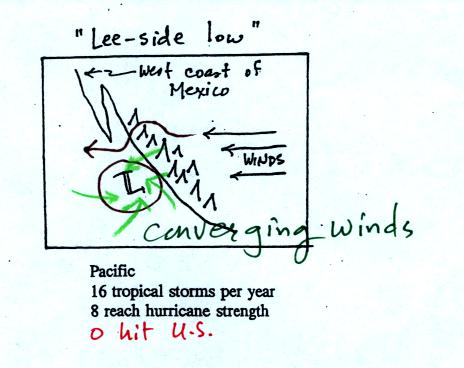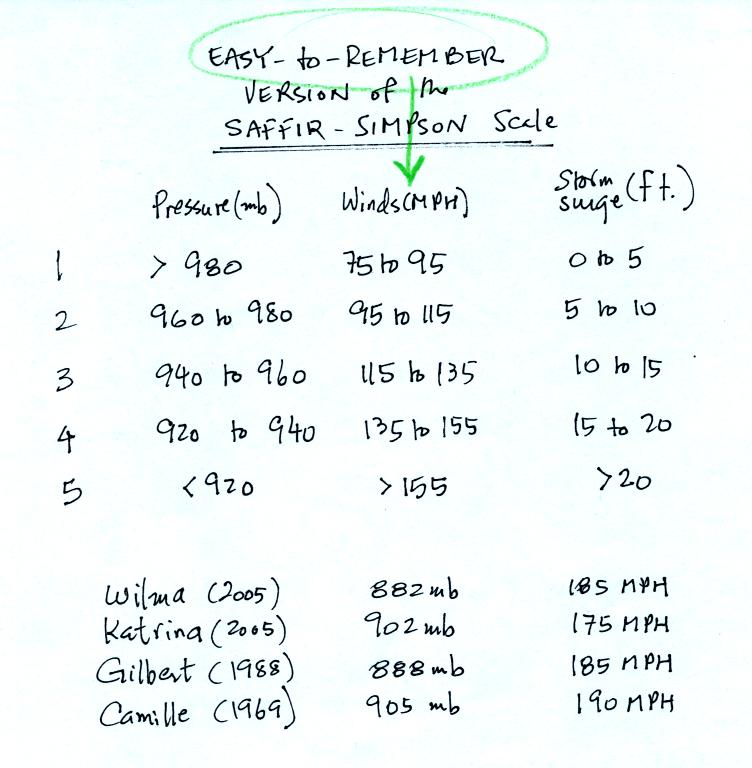Monday Nov. 30, 2009
click here to download today's notes in a more
printer friendly format
Three songs ("Ninna Nanna", "Ou Est Ma Tete", and "But Now I'm
Back") from Pink Martini's latest CD "Splendor in the Grass" before
class
today.
Answers
to the most recent Optional Assignment.
All of the 1S1P Assignment #2 reports have been graded (everyone was
given full credit for the "story" reports; I haven't had time to read
them yet and therefore haven't returned them). The list of students that have earned 45
pts or have nearly earned 45 pts has been updated. It will
continue to be updated during the week as I begin to grade Assignment
#3 reports. You have until Friday to turn in Assignment #3
reports.
Quiz #4 is this week. Reviews will be held at the usual
locations and at the usual times. See the Quiz #4 Study Guides (Pt. 1 and Pt.
2) for more details.
We spent the first part of the class today reviewing some lightning
safety rules and information. This was stuck onto the end of the Monday Nov. 23 notes.
We will
spend the next two classes on Hurricanes. This will be the final
topic
that we cover this semester. There won't be any questions about
hurricanes on this weeks quiz but there will be some questions on the
final exam.
A good place to begin is to compare hurricanes (tropical cyclones)
with
middle latitude storms (extratropical cyclones). To
speed things up, I'm borrowing some of the figures below from a
previous semester. The figures may differ slightly from those
drawn in class.
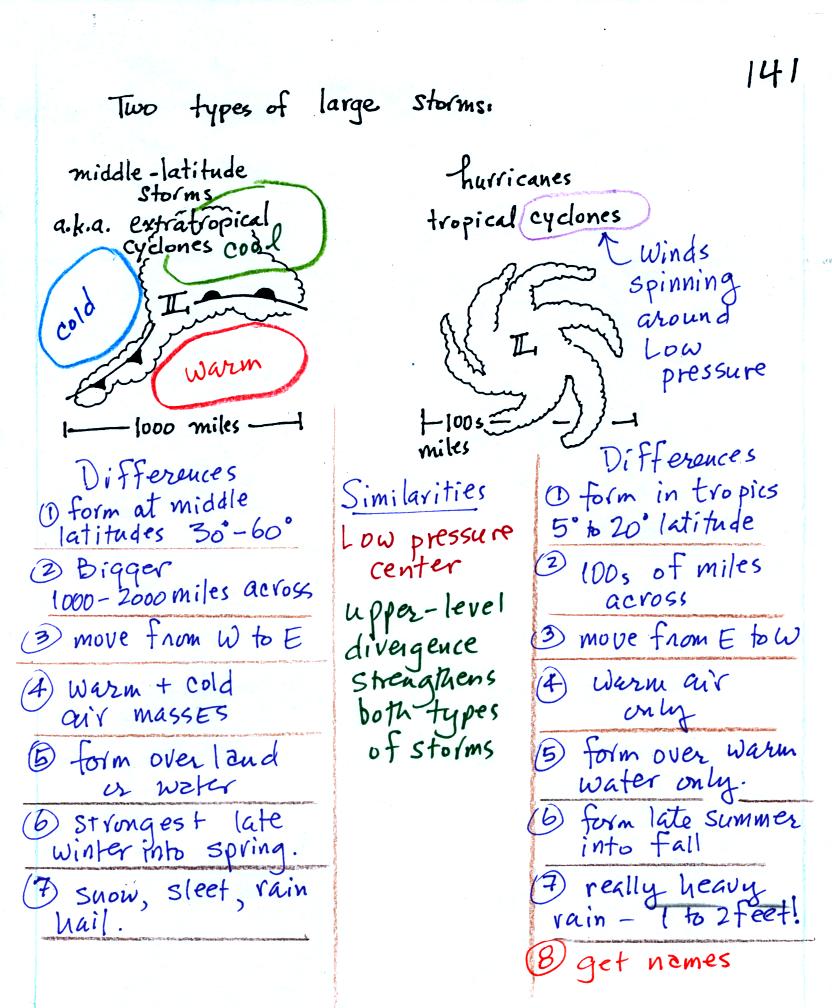
Hurricanes and middle latitude
storms have a couple of characteristics in common:
a. they both form around surface centers of
low pressure (that is why the term cyclone appears in the names of both
types of storms). Upper level divergence can
lower the surface pressure
which then can cause both types of storms to intensify.
1,2. Middle latitude storms (MLS) form at middle latitude (between
30 and 60 degrees latitude) and are generally bigger than
hurricanes. A large middle latitude storm might cover half of the
United States. Hurricanes form in the tropics, a big hurricane
might fill the Gulf of Mexico.
3. MLS form in the prevailing westerly wind belt and move from west to
east. Hurricanes form in the trade winds and move from east to
west.
4,5. MLS can form over land or water. Fronts separate warm, cold,
and cool air masses. Hurricanes only form over very warm ocean
water and are made entirely of warm moist air.
6. The strongest middle latitude storms form in the
winter and
early
spring. Peak hurricane activity occurs in the late summer into
the fall.
7. MLS can produce a variety of different types
of precipitation. Hurricanes mostly just produce very large
amounts of rain. Hurricanes do contain thunderstorms so hail and
graupel as also possible.
8. Hurricanes receive names (when they reach tropical storm
strength). The names now alternate male and female. The
names of particularly strong or deadly hurricanes (such as Katrina) are
retired, otherwise the names repeat every 6 years.
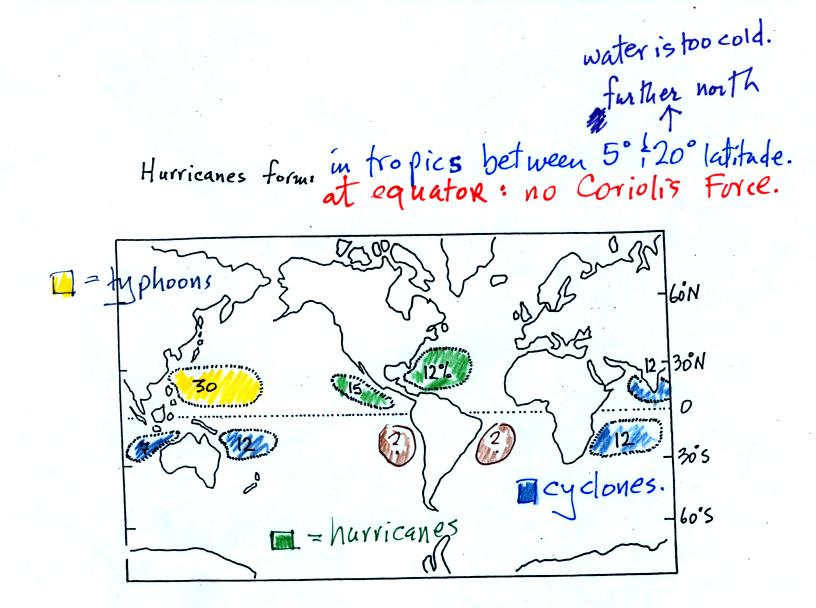
The figure above shows
the relative frequency of
tropical cyclone
development in different parts of the world.
The name hurricane, cyclone, and typhoon all refer to the same type of
storm (tropical cyclone is a general name that can be used
anywhere). In most years the ocean off the coast of SE Asia is
the
world's most active hurricane zone. Hurricanes are
very rare off
the east
and west coasts of South America.
Hurricanes form between 5 and 20 degrees latitude,
over warm ocean
water, north and south of the equator. The warm
layer of water
must be fairly deep to contain enough energy to fuel a hurricane and so
that turbulence and mixing don't bring cold water up to the ocean
surface. The atmosphere must be unstable so that thunderstorms
can develop. Hurricanes will only form when there is very little
or no vertical wind shear (changing wind direction or speed with
altitude). Hurricanes don't form at the equator because there is
no Coriolis force there (the Coriolis force is what gives hurricanes
their spin and it causes hurricanes to spin in opposite directions in
the northern and southern hemispheres.
Note that more tropical
cyclones form off the
west coast of the US than
off the east coast. The west coast hurricanes don't generally get
much attention, because they move away from the coast and usually
don't
present a threat to the US (except occasionally to the state of
Hawaii). The moisture from these storms will
sometimes be pulled up into the southwestern US where it can lead to
heavy rain and flooding.
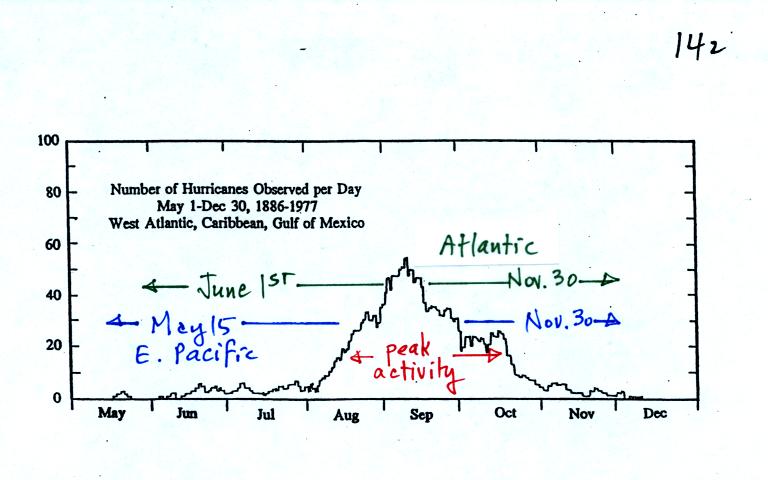
Hurricane season in the Atlantic
officially runs from
June 1 through to November 30. The peak of hurricane season is in
September. In 2005, an unusually active hurricane season in the
Atlantic, hurricanes continued through December and even into January
2006. Hurricane season in the Pacific begins two weeks earlier on
May 15 and
runs through Nov. 30.
Some kind
of meteorological process that produces low
level
convergence
is needed to initiate a hurricane. One possibility, and the one
that fuels most of the strong N. Atlantic hurricanes, is an "easterly
wave." This is just a "wiggle" in the wind flow pattern.
Easterly waves often form over Africa or just off the African coast and
then travel toward the west across the N. Atlantic. Winds
converge as they approach the wave and then diverge once
they are
past it . The convergence will cause air to rise and
thunderstorms
to begin to develop.
In an average year, in the N.
Atlantic, there will be 10 named
storms
(tropical storms or hurricanes) that develop during hurricane
season. 2005 was, if you remember, a very unusual
year. There
were 28 named storms in the N. Atlantic in 2005. That beat the
previous record of 21 names storms that had been set in 1933. Of
the 28 named storms, 15 developed into hurricanes.
In some ways winds blowing through an easterly wave resembles
traffic
on a multi-lane highway. Traffic will back up as it approaches a
section of the highway with a closed lane. Once through the
"bottleneck" traffic will begin to flow more freely.
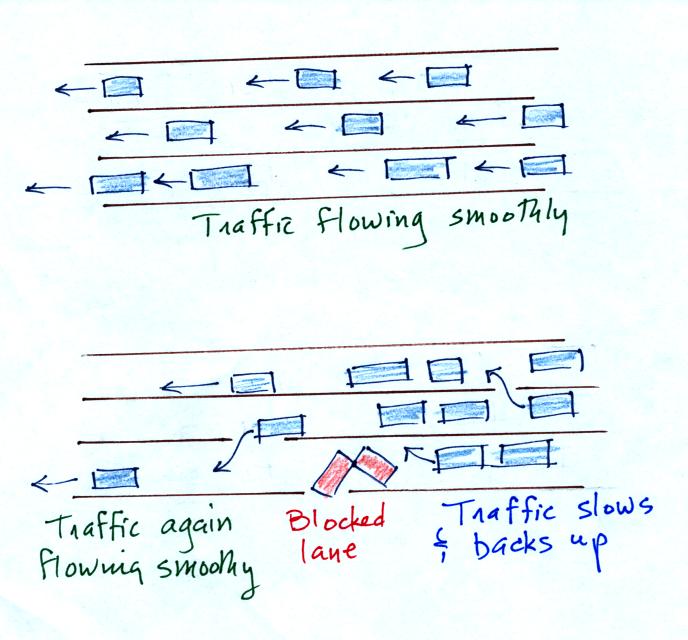
Another process that causes surface
winds to converge is a "lee side low."
This figure tries to explain how a
cluster of thunderstorms can organize and intensify into a hurricane.

1. Converging surface winds pick
up heat and moisture from the ocean. These are the two mains
sources of energy for the hurricane.
2. Rising air cools and thunderstorm clouds form. The
release of latent heat during condensation warms the atmosphere.
The core of a hurricane is warm.
3. Pressure decreases more slowly with increasing altitude
in the warm core of the hurricane. The result is that pressure at
the top center of the hurricane is higher than the pressure at the top
edges of the hurricane (pressure at the top center is still lower than
the
pressure at the bottom center of the hurricane). Upper levels
winds diverge and spiral outward
from the top center of the hurricane.
4. The upper level divergence will cause the surface
pressure at the center of the hurricane to decrease. The speed of
the converging surface winds increases
and the storm intensifies. The converging winds pick up
additional heat and moisture which warms the core of the hurricane even
more. The upper level high pressure and the upper level
divergence increase. The increased divergence lowers the surface
pressure even more.
That was
about all the new material we had time to cover in class because a
20
minute segment from a NOVA program (PBS network) on hurricanes was
shown. A film crew was on board a NOAA
reconnaissance plane as it flew into the narrow eye of hurricane
GILBERT. Gilbert set the record low sea level pressure reading
for the Atlantic ocean (888 mb). That record stood until the 2005
hurricane season when WILMA set a new record of 882 mb. The world
record low sea level pressure, 870 mb, was set in a SE Asian typhoon in
1979.
Here are some of the comments written down during the video (these
were
on the back of the handout distributed in class. We
will review the Saffir Simpson scale in class on Friday and look at
the 3-dimensional structure of hurricanes in more detail.
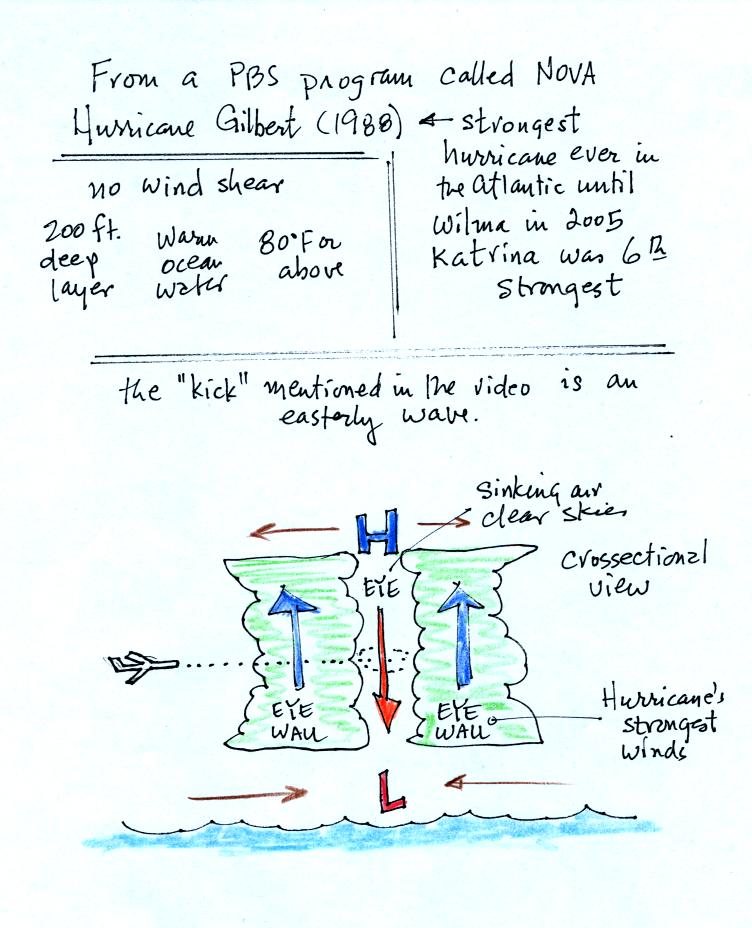
One of the most distinctive
features of a hurricane is the clear eye in the center. The eye
is produced by sinking air. Once in the eye, the people in the
NOAA plane where able to see blue sky when they looked and and saw the
ocean surface when they looked down. The eye of a hurricane is
something that very few people will ever see. The eye is
surrounded by the eye wall, a ring of strong thunderstorms.
The Saffir simpson
scale is used to rate hurricane intensity or damage potential.
We'll talk more about hurricane damage in class on Friday.
The stages
of storm development that lead up to a hurricane are shown
at the bottom of p. 143a in the photocopied ClassNotes.
A tropical disturbance is just a localized cluster of thunderstorms
that a meterologist might see on a satellite photograph. But this
would merit observation because of the potential for further
development. Signs of rotation would be evidence of organization
and the developing storm would be called a tropical depression.
In order to be called a tropical storm the storm must
organize a little
more, and winds must
increase to 35 knots. The storm receives a name at this
point. Finally when winds exceed 75 MPH (easier to remember than
65 knots or 74 MPH) the storm becomes a hurricane.






